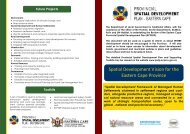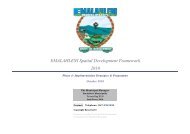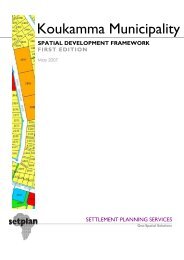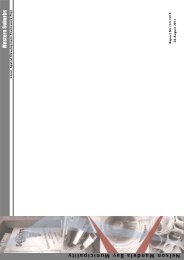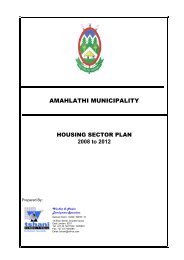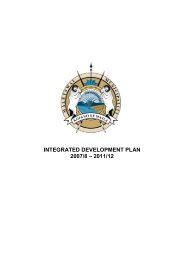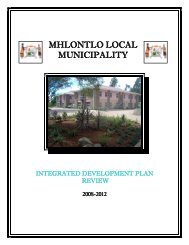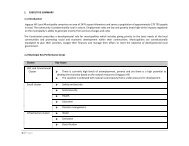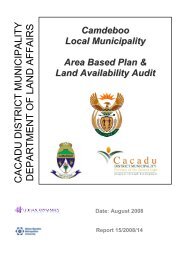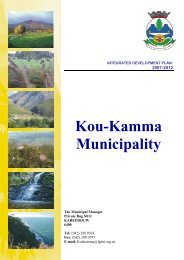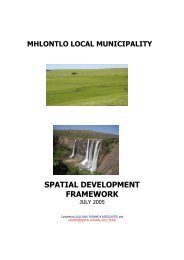intsika yethu local municipality - Provincial Spatial Development plan
intsika yethu local municipality - Provincial Spatial Development plan
intsika yethu local municipality - Provincial Spatial Development plan
Create successful ePaper yourself
Turn your PDF publications into a flip-book with our unique Google optimized e-Paper software.
The constitutional allocation of ‘original powers’ to Local Government produces at least two areas ofoverlap, namely supervisory overlap and overlap between matters listed in the Schedules. The Constitutiondoes not allocate the matters in Schedule 4B and 5B exclusively to Local Government; National and<strong>Provincial</strong> Government may also regulate those matters. The Local Government matters listed in Schedule4B are part of the concurrent provincial and national legislative competence “to the extent set out insection 155(6) (a) and (7)”. Similarly, the Local Government matters listed in Schedule 5B are part of theexclusive provincial competence “to the extent set out for provinces in section 155(6) (a) and (7)”. Nationaland <strong>Provincial</strong> Governments have the authority to ensure that municipalities adequately perform inrespect of these matters. The Constitution provides that, subject to section 151(4), a by-law that conflictswith national or provincial legislation is invalid.Section 155(6) (a) of the Constitution states that <strong>Provincial</strong> Government has a duty to monitor and supportLocal Government in its jurisdiction. The Province must assert legislative and executive power in order topromote the development of <strong>local</strong> government’s capacity to perform its functions and manage its affairsand they may do so by regulating municipal executive authority, thus ensuring the municipalities’ effectiveperformance of their functions in respect of listed <strong>local</strong> government matters. Taken together, thesecompetencies are considerable and facilitate a measure of <strong>Provincial</strong> Government control over the mannerin which municipalities administer those matters in Part B of Schedules 4 and 5. This control is not purelyadministrative. It could encompass control over municipal legislation to the extent that such legislationimpacts on the manner of administering Local Government matters.Another consideration relates to the role and function of traditional leaders and how they are to beincorporated into the Local Government structures and procedures in future. The Traditional Leadershipand Governance Framework Act (Act 41 of 2003) provides that the MEC for Local Government andTraditional Affairs appoint representatives of traditional leaders to participate in the Council as providedin the Municipal Systems Act (Act 32 of 2000). In this regard the issue of land administration between theMunicipality and the traditional leaders is a challenge that needs to be addressed. The challenge ariseswhen traditional leaders continue to allocate land to communities without engaging the <strong>municipality</strong> toascertain issues relating to township establishment and land development requirements generally. Thismay result in communities occupying sites in which no services have been provided and where no formalprocedures are followed.This situation leads to a host of other challenges which including health related problems, occupation ofland not suitable for human settlement, compounding existing challenges of poverty eradication. IYLMand relevant traditional leadership structures must devise a system of engagement and cooperation inorder to address this challenge.It is obvious that without clarity on power, duties and functions (responsibilities) between theseinstitutions it becomes very difficult to design strategies and formulate projects and budget accordingly.This has been a significant problem in the IYLM IDP development process in the past. It is in this regardthat, this issue is identified by IYLM and is essential that a concerted effort be sustained in order to resolvematters pertaining to the allocation of powers, duties and functions pertaining to all disciplines.As far as powers and functions are concerned, CHDM performs certain functions within IYLM.Additionally, due to existing low capacity in some areas, CHDM will, in consultation with LocalMunicipalities, enter into a contract with the external service provider to supplement capacity. It remains atwo-way commitment between a Local Municipality and the District Municipality to build adequatecapacity for accelerated service delivery. Below is a table of the Powers and Functions distributed betweenCHDM and IYLM as authorised, and as per the status quo.17



